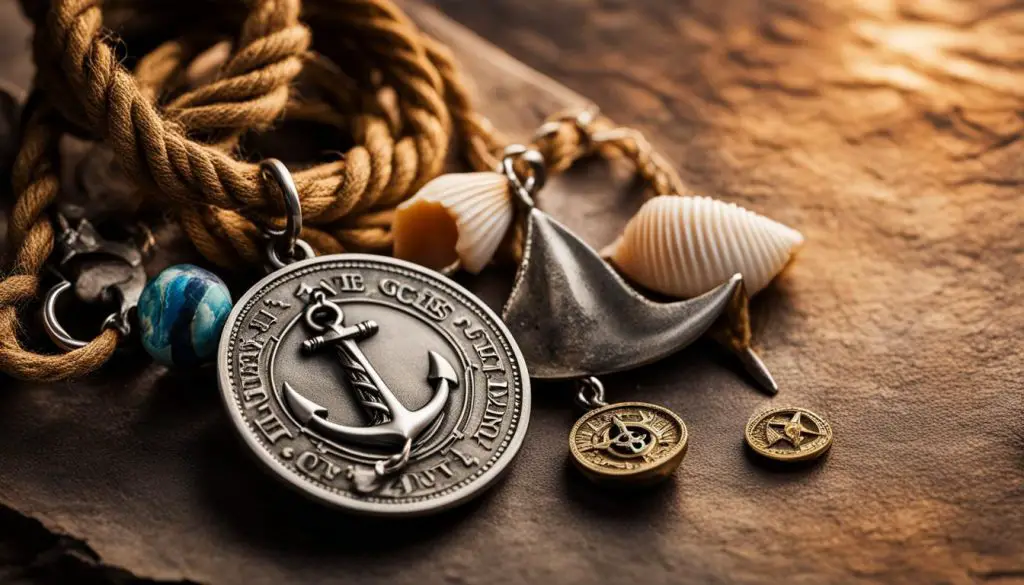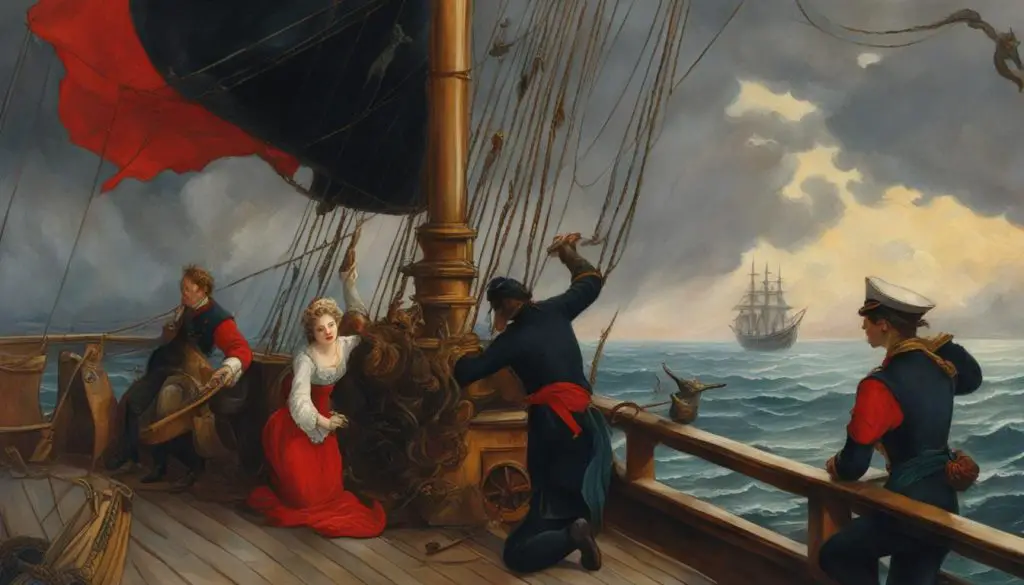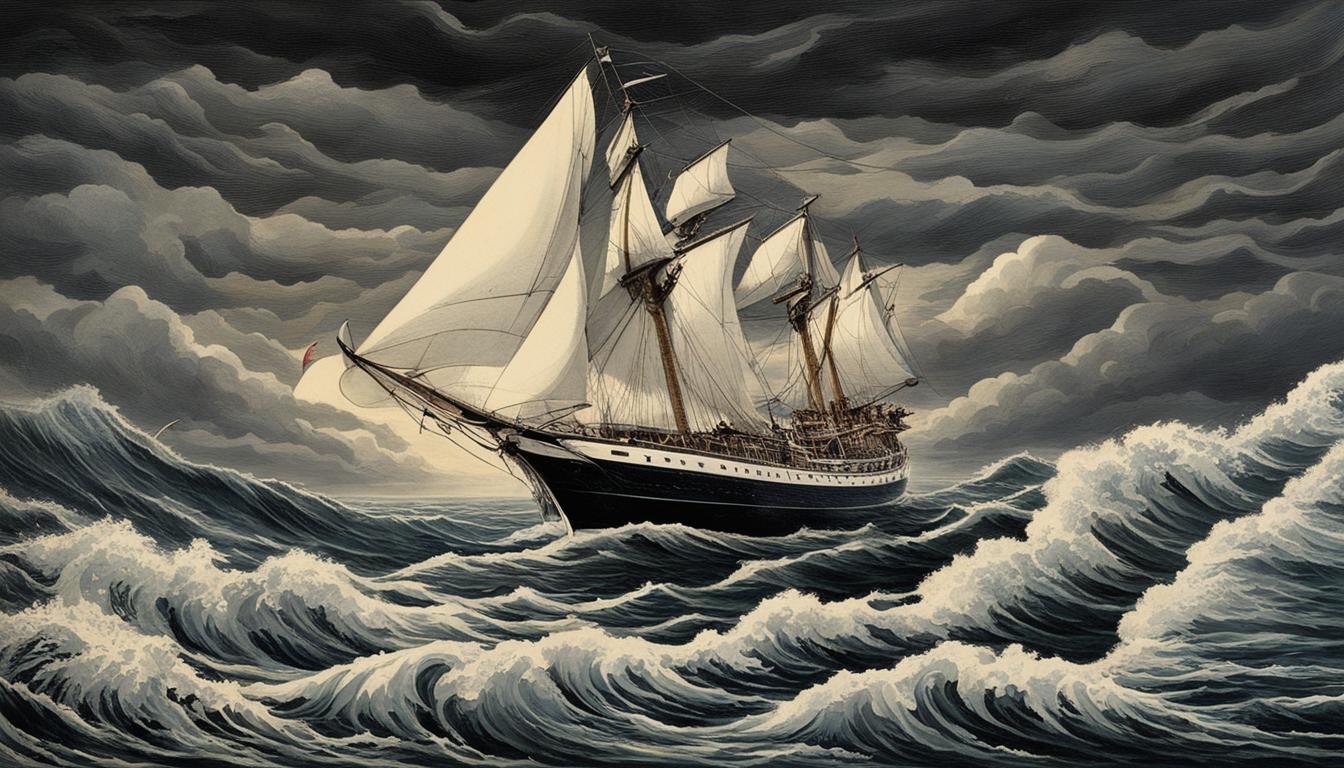Sailors have long held superstitions and traditions to bring good luck and avoid bad luck at sea. These beliefs, rooted in nautical folklore, have been passed down through generations. From lucky charms to observing omens, sailors have developed their own customs and rituals to navigate the unpredictable seas.
In this article, we will explore sailor superstitions, sailing traditions for good luck, and delve into the fascinating world of nautical folklore.
Contents
- 1 Signs of Bad Luck at Sea
- 2 Lucky Charms and Rituals
- 3 The Importance of Patron Saints
- 4 Conclusion
- 5 FAQ
- 5.1 What are some signs of bad luck at sea?
- 5.2 What were some lucky charms and rituals sailors used?
- 5.3 Who were the patron saints sailors turned to for protection and guidance?
- 5.4 What were some outdated and dangerous superstitions held by sailors?
- 5.5 What insight do sailor superstitions and traditions provide?
- 6 Source Links
Key Takeaways:
- Sailors have a rich tradition of superstitious beliefs for good luck at sea.
- Signs of bad luck include red sunrises, Fridays, and encounters with certain creatures.
- Lucky charms and rituals, such as having a cat on board or tossing a coin into the water, are common practices.
- Patron saints, like St. Nicholas and St. Brendan, were revered for their protection and guidance.
- Some sailor superstitions were outdated and discriminatory, based on old beliefs and notions.
Signs of Bad Luck at Sea
Sailors have always been wary of signs that could indicate bad luck at sea. These omens and superstitions have been passed down through generations, shaping the beliefs and practices of seafarers. Exploring these signs gives us a glimpse into the rich folklore and traditions that have surrounded the maritime world.
One of the most well-known signs of bad luck at sea is a red sunrise. Sailors believe that a red sky in the morning signifies an impending storm or rough conditions ahead. This belief is rooted in meteorology, as a red sunrise can indicate the presence of high humidity and moisture, which can lead to unstable weather. Hence, the saying “Red sky at night, sailor’s delight; red sky in the morning, sailor take warning.” This age-old adage reflects the caution and vigilance sailors have maintained throughout time.
In addition to red sunrises, certain days were considered unlucky for sailors. Fridays were believed to bring misfortune, with some ships refusing to set sail on this day. Candlemas Day, celebrated on February 2nd, was also considered unlucky, and sailors would avoid embarking on voyages during this time. These superstitions highlight the deep-rooted beliefs and cautionary measures sailors took to avoid potential dangers.
Furthermore, sailors believed that encountering certain creatures or having women on board could bring bad luck. The Sirens, mythical creatures who lured sailors to their doom with their enchanting songs, were feared for their ability to cause shipwrecks. Scylla, another legendary sea monster, was believed to devour sailors who ventured too close. Sailors also had the superstition that having women on board was unfortunate, as they were seen as distractions and could potentially anger the sea gods. These beliefs reflect the deep respect sailors held for the unpredictable and treacherous nature of the sea.
Sailors’ Superstitions: Unlucky Days and Omens
| Signs of Bad Luck | Explanation |
|---|---|
| Red sunrise | Indicates potential stormy weather |
| Fridays | Considered an unlucky day to set sail |
| Candlemas Day | Believed to bring misfortune |
| Sirens and Scylla encounters | Feared for their ability to cause shipwrecks |
| Women on board | Seen as potential distractions and angering the sea gods |
These signs of bad luck not only showcase the superstitions of sailors but also highlight their resilience and vigilance in the face of the unpredictable sea. By recognizing and respecting these omens, sailors hoped to mitigate potential risks and ensure a safer journey.
Lucky Charms and Rituals
Sailors have long relied on lucky charms and rituals to bring good fortune on their voyages. These maritime customs and sailor traditions are deeply ingrained in seafaring culture, serving as a source of comfort and a way to ward off bad luck.
One popular lucky charm among sailors was having a cat on board. Cats were believed to bring good luck and protect the ship from rodents. It was thought that their presence would also attract favorable winds, ensuring a smooth and successful journey. Sailors would often keep cats as companions and guardians during their time at sea.
“A ship without a cat is like a ship without a soul.”
Another intriguing sailor tradition involved ear piercing. Sailors would pierce their ears as a way to improve their sight and avoid harm at sea. It was believed that this act would enhance their intuition and enable them to navigate treacherous waters more effectively.
| Lucky Charms and Rituals | Description |
|---|---|
| Cat on Board | Believed to bring good luck, protect from rodents, and attract favorable winds. |
| Ear Piercing | Thought to improve vision and enhance intuition for safer navigation. |
| Coin Toss into the Water | Tradition of throwing a coin into the water to buy wind and ensure a swift voyage. |
| Whistling for Wind | Sailors would whistle to increase the strength of the wind and propel the ship forward. |
Another fascinating sailor tradition was the act of tossing a coin into the water. Sailors would throw a coin into the sea as an offering to the spirits, hoping to buy wind for a favorable and swift voyage. This gesture symbolized the sailors’ desire for a safe and prosperous journey.
Furthermore, whistling for wind was a common practice among sailors. They believed that whistling could increase the strength of the wind, propelling the ship forward. This ritual was often performed when the wind was weak or when the ship needed an extra boost of speed.
These sailor traditions and good luck rituals at sea not only provided sailors with a sense of security but also served as a way to bond and unite the crew. By participating in these customs, sailors upheld their shared heritage and maintained a connection to the vast history of seafaring.

Sailor Traditions in Modern Times
In modern times, while some sailors may still adhere to these age-old customs, many have evolved or fallen by the wayside. The advancements in navigation technology and the changing dynamics of the maritime industry have led to a shift in focus. However, the rich history and folklore associated with these traditions continue to fascinate and intrigue sailors and maritime enthusiasts alike.
The Importance of Patron Saints
Sailors have long turned to patron saints for protection and guidance during their voyages. These revered figures, known as sailor guardians, offer comfort and reassurance to those who face the perils of the sea. Two prominent patron saints in maritime beliefs are St. Nicholas and St. Brendan.
St. Nicholas, often depicted as a bishop, is widely recognized as the patron saint of sailors. According to legend, he possessed the ability to calm storms with his prayers, making him a beacon of hope for sailors in need. Sailors would often invoke his name and seek his intervention during tumultuous weather. St. Nicholas became a symbol of protection and safety at sea, earning the devotion of many seafarers.
St. Brendan, the legendary Irish navigator, is also revered as a patron saint of sailors and navigators. Known as the “Voyager” or the “Navigator,” St. Brendan embarked on a legendary voyage, traversing the Atlantic Ocean in a small boat. His voyage served as a source of inspiration for countless sailors throughout history. Sailors would pray to St. Brendan for guidance and safe passage during their own journeys, believing in his ability to navigate treacherous waters.
| Patron Saint | Symbolism |
|---|---|
| St. Nicholas | Calming storms, protection at sea |
| St. Brendan | Safe navigation, guidance in treacherous waters |
These patron saints hold great significance in maritime folklore, representing a connection between the spiritual realm and the challenges faced by sailors. Whether it was the assurance of St. Nicholas’ calming presence or the guidance of St. Brendan’s legendary journey, sailors found solace and strength in their devotion to these saints. Their belief in the intercession of patron saints offered a sense of security amidst the unpredictable and often dangerous nature of the sea.

Sailors have always been surrounded by superstitions and customs, many of which have been passed down through generations. While some of these beliefs were harmless and provided a sense of tradition and comfort, others were outdated and even dangerous. It is important to understand the distinction between harmless folklore and beliefs that could potentially put lives at risk.
One such dangerous belief is the notion that saving a drowning person at sea would bring bad luck. This superstition, based on fear and misconceptions, discouraged sailors from assisting those in distress, leaving them vulnerable to harm. This belief undermines the value of human life and disregards the fundamental duty of seafarers to aid those in need.
Another harmful custom was the belief that certain individuals, such as redheads, people with blue eyes, and women on board, were considered bad omens. Such discriminatory beliefs not only perpetuated prejudice and exclusion but also created an unwelcoming environment for diverse crew members. In a profession that relies on teamwork and camaraderie, it is essential to foster inclusivity and equality.
| Superstition | Danger Level | Explanation |
|---|---|---|
| Saving a drowning person brings bad luck | Dangerous | Discouraged assistance to those in distress |
| Redheads, blue-eyed individuals, and women on board are bad omens | Dangerous | Promoted discrimination and exclusion |
It is important to recognize and challenge these outdated beliefs, fostering a more inclusive and progressive maritime community. By promoting a culture of respect, understanding, and evidence-based thinking, we can navigate the seas with a clearer mind and open heart, ensuring the safety and well-being of all sailors.
Conclusion
Sailor superstitions and traditions are a fascinating part of maritime lore. Throughout history, sailors have held steadfast beliefs and practices to bring good luck and ward off bad luck at sea. These customs, rooted in nautical traditions, provide insight into the lives and mindset of seafarers.
Carrying lucky charms, observing omens, and seeking the protection of patron saints were all ways in which sailors navigated the unpredictable seas. While these beliefs may seem superstitious or outdated today, they hold a significant place in seafaring history.
Maritime lore is a testament to the ingenuity and resourcefulness of sailors. It reflects their deep connection to the sea and their desire to understand and control the forces that governed their journeys. Though modern sailors may not adhere to these customs, they remain a rich part of our nautical heritage.
So whether it’s the tale of a lucky cat on board, the cautionary signs of a red sunrise, or the comforting presence of patron saints, sailor superstitions and traditions continue to captivate our imagination and remind us of the brave souls who have ventured into the unknown depths of the ocean.
FAQ
What are some signs of bad luck at sea?
Some signs of bad luck at sea include a red sunrise, Fridays, Candlemas Day, encountering certain creatures, and having women on board.
What were some lucky charms and rituals sailors used?
Sailors believed that having a cat on board brought good luck, as well as piercing their ears to improve their sight. They would also toss a coin into the water to buy wind and whistle to increase wind strength.
Who were the patron saints sailors turned to for protection and guidance?
Sailors turned to St. Nicholas, known for calming storms with his prayers, and St. Brendan, a legendary navigator, as patron saints for protection and guidance.
What were some outdated and dangerous superstitions held by sailors?
Some outdated and dangerous superstitions held by sailors included the belief that saving a drowning person would bring bad luck and that redheads, people with blue eyes, and women on board were bad omens.
What insight do sailor superstitions and traditions provide?
Sailor superstitions and traditions provide insight into the lives and mindset of sailors throughout history and their customs and rituals to navigate the unpredictable seas.





